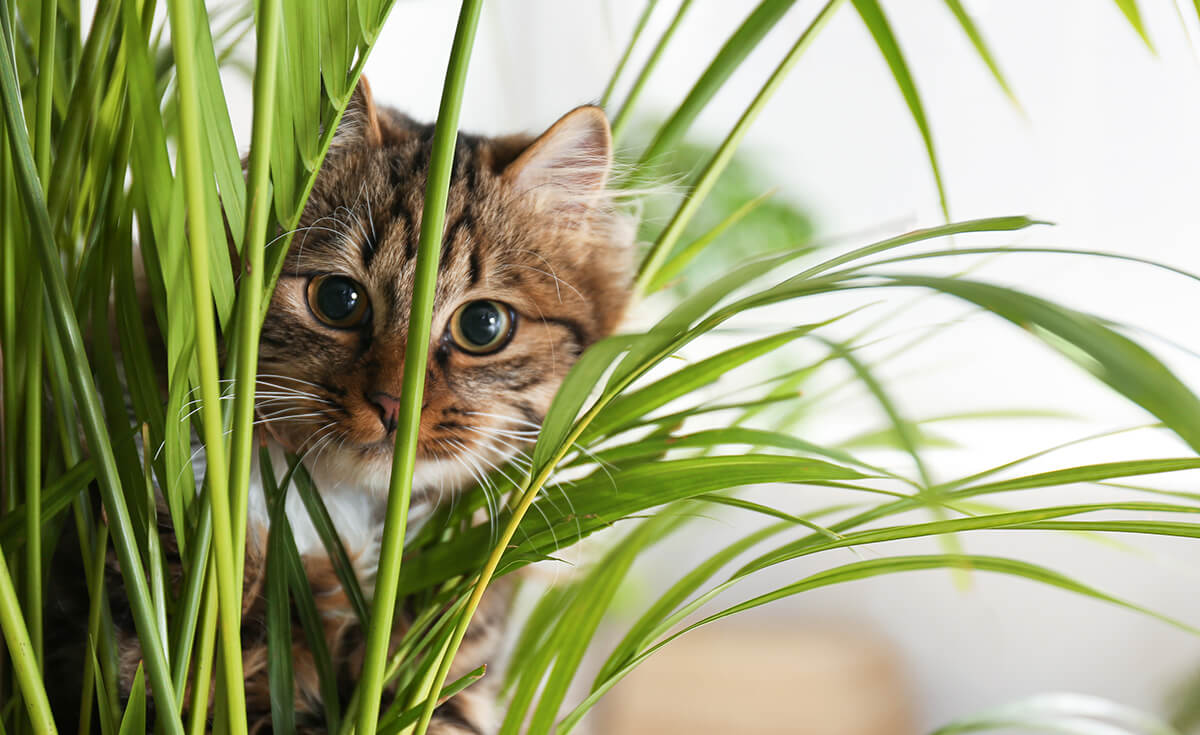A Pet Parent’s Guide to Plants Toxic to Cats
In this comprehensive guide, we’ll cover everything you need to know about plant toxicity in cats. We’ll discuss the types of plants that can pose a danger, signs of toxicity, and how to prevent accidental ingestion. By the end, you’ll be equipped with the knowledge to spot toxic plants, understand the risks they pose, and choose non-toxic alternatives for a pet-friendly home.

As pet parents, our homes are shared spaces with our beloved animals, spaces where hazards can sometimes hide in plain sight. And it’s important to be aware that numerous plants – in fact, more than 700 species – are toxic to cats.
Understanding Plant Toxicity in Cats
The concept of plant toxicity in cats goes beyond just avoiding the nibble of a leaf or stem. It’s about understanding the specific dangers that certain plants present to our feline friends.
These plants contain toxins that can cause a range of symptoms from mild irritation to severe health issues like kidney failure. Knowing which plants are safe and which are not can help prevent these risks.
In the following sections, we’ll look at the toxins found in common indoor plants and outdoor plants, highlight the symptoms of toxicity, and guide you on how to react if your cat has been exposed. By educating ourselves as cat parents, we can create a living space that’s both beautiful and safe for our pets.
Common Plants That Are Toxic to Cats
Identifying toxic plants is crucial to keeping your feline out of harm’s way. Some of these plants are common household favorites, but they can cause serious health issues if your cat ingests them. Let’s take a closer look at these plants to understand why they’re dangerous and what symptoms they might cause.
Lilies
Lilies pose a significant danger to your feline friends. Just a nibble or lick can trigger severe symptoms like vomiting, decreased appetite, and increased urination leading to dehydration, and ultimately kidney failure in cats.
Every part of the lily plant is toxic to cats, including the petals, leaves, pollen, and even water from a vase holding these blooms.
As a responsible pet parent, it’s extremely important to either eliminate lilies from your home and garden or ensure that they’re completely inaccessible to your curious cat.
Aloe Vera
Aloe Vera, a common plant found in many homes and gardens, poses a significant threat to our feline friends. Despite its medicinal properties for humans, when ingested by cats it can cause symptoms including vomiting, diarrhea, lack of appetite, depression, and even tremors.
The saponins found in this plant serve as potent irritants to the gastrointestinal tract of cats, posing a severe health risk. If your feline is known to chew on houseplants, it’s essential to either place this plant well beyond their reach or to remove it from your home entirely to prevent any chance of ingestion.
If you suspect your cat has ingested Aloe Vera or is displaying symptoms of poisoning such as changes in behavior or physical distress, seek veterinary help immediately for effective treatment.
Sago Palm
Sago palm, also known as Cycas revoluta, may seem like an attractive addition to your home or garden, but it’s important to know that this plant is highly toxic and poisonous to cats.
Every part of the sago palm contains a toxin called cycasin, which can cause severe symptoms if ingested by your furry friend. Even a small amount can lead to vomiting, diarrhea, liver failure, and even death.
It’s crucial to keep sago palms out of reach and ensure that your cat cannot access them in any way to keep them safe from this poisonous plant. The ingestion of sago palm is a veterinary emergency, and immediate treatment is crucial for a successful outcome.
Ivy
Ivy’s lush greenery might be tempting to have around the house, but it’s unsafe for cats. In fact, all types of ivy are toxic to cats, and can cause symptoms including vomiting, diarrhea, and skin irritation.
Cats can climb just about anything, making it tough to keep ivy away from them. For their safety, it’s smarter to have other attractive, non-toxic plants in your home.
Autumn Crocus
Autumn Crocus, also known as Meadow Saffron, is a beautiful flowering plant that’s highly toxic to cats. The entire plant, including the bulbs and seeds, contains a toxic component called colchicine.
If ingested by cats, it can cause severe gastrointestinal tract irritation and even organ failure. Symptoms of Autumn Crocus poisoning in cats include difficulty swallowing, excessive drinking, vomiting, diarrhea, and abdominal pain.
It’s crucial to be aware of the dangers posed by Autumn Crocus and keep this plant out of reach of your kitty. And of course, visit your vet immediately if you think your cat may have ingested this plant.
Mistletoe
Mistletoe is a popular plant during the holiday season, but it’s toxic to cats. Ingesting mistletoe can lead to gastrointestinal upset, including vomiting and diarrhea. It may also cause more serious symptoms such as difficulty breathing or an increased heart rate.
If you suspect that your cat has consumed mistletoe, it’s vital to seek veterinary care immediately. Keep your furry friend safe by avoiding bringing mistletoe into your home or hanging it in areas where your cat has access.
Chrysanthemum
Chrysanthemums are beautiful flowers often found in gardens and floral arrangements, but they’re toxic to cats. These plants contain pyrethrins, which can cause stomach upset, vomiting, drooling, and diarrhea if ingested by your furry friend.
It’s important to keep chrysanthemums out of reach of your cat or opt for non-toxic alternatives when decorating your home or garden.
Amaryllis
Amaryllis is another plant that pet parents need to be aware of, as it is toxic to cats. This beautiful flowering plant contains alkaloids and lycorine, which can cause vomiting, diarrhea, abdominal pain, and even tremors if ingested by a cat.
Make sure to keep Amaryllis out of your cat’s reach to prevent any accidental ingestion and potential health issues.
If you ever suspect that your cat has ingested a toxic plant, it’s vital to act swiftly. Many plants toxic to cats can cause symptoms that escalate quickly, and the sooner you respond, the better your cat’s chances for a full recovery.
Poisonous plants can range from the common sago palm to the seemingly harmless snake plant (or mother-in-law plant), and each has its own level of toxicity. The first step should always be to contact your veterinarian or the ASPCA Animal Poison Control hotline at (888) 426-4435 for immediate advice.
It’s also a good practice to keep a list of plants toxic to cats handy, especially if you’re unsure about the plant material your cat has encountered. If possible, take a sample of the plant or take a photo that you can show to your vet or the poison control expert, as this will help them to provide specific care instructions.
It’s also important to recognize that many people may not be aware of the dangers certain other plants present. Household favorites like the corn plant, or beautiful garden selections such as the showy daisy, are also potentially hazardous to our feline friends.
Non-Toxic Plants for Cats
Now for the good news – there are plenty of non-toxic plants that you can safely keep in your home and garden. These safe options let you enjoy greenery and flowers without risking your cat’s health. Keep reading for a few fantastic indoor and outdoor options.
Safe Indoor Plants
Keeping your feline friends safe doesn’t mean you have to give up on your love for indoor plants. There are a number of beautiful, safe indoor plants that won’t harm your cats if ingested. Here are a few to consider:
- Spider Plant (Chlorophytum comosum). These plants are easy to grow and non-toxic to cats. They produce long, thin, arching leaves that are green and white. Spider plants like bright, indirect light and watering once a week.
- Bamboo Palm (Chamaedorea seifrizii). Bamboo Palms are safe for cats and also help to purify the air in your home.They prefer indirect light and need to be watered when the top inch of soil is dry.
- Boston Fern (Nephrolepis exaltata). Boston Ferns are non-toxic to cats and dogs. They add a touch of greenery to any room with their lush fronds. These plants like high humidity, so they’re perfect for a bathroom or kitchen. Water them when the top layer of soil feels dry.
- Areca Palm (Dypsis lutescens). Areca Palms are pet-safe and can grow up to 6 to 7 feet tall, making a great statement piece in any room. They need bright, indirect light and watering when the top 1-2 inches of soil are dry.
- Money Tree (Pachira aquatica). Money Trees are safe for cats and are known for their braided trunks and bright, glossy leaves. They prefer indirect light and should be watered when the top 2-4 inches of soil are dry.
Remember, even non-toxic plants can cause gastrointestinal upset if consumed in large amounts, so it’s always best to keep an eye on your cat’s interactions with plants.
Safe Outdoor Plants
While many plants pose a danger to your feline friends, there are plenty of safe outdoor plants that you can let your cat explore without worry. Here are some of them:
- Rose. Roses are not only beautiful, but also safe for cats. Their thorny stems can help discourage cats from climbing.
- Sunflower. These large and vibrant plants are non-toxic to cats. They can provide shade and visual interest for curious cats.
- Zinnia. Zinnias are colorful and safe flowers for your feline companions. Their bright colors can attract butterflies, providing entertainment for your cats.
- Thyme. This fragrant herb is safe for cats to sniff, rub against, or even ingest. Thyme can even help with digestive problems if ingested by your cat.
- Catnip. Safe and often beneficial, catnip is a great choice for cats. Many cats love it, and it can provide them with hours of fun and relaxation.
Remember, it’s important to always watch over your cat when they’re outdoors exploring plants. Even though you may have non-toxic plants in your garden, cats can still have unexpected reactions or overindulge.
Plus, being outdoors means there’s a chance they might wander and nibble on plants toxic to cats that are growing wild or in neighboring yards. Close supervision ensures they stay safe and don’t eat anything they shouldn’t.
Preventing Plant Toxicity in Cats
In the fight against plant toxicity, knowledge is your first line of defense. This section will guide you through the steps necessary to create a safe environment for your cat, from scrutinizing plant labels and researching potential new greenery, to pet-proofing your home against toxic plants.
We’ll also touch on how to spot the worrying signs of plant toxicity and the measures you should take if your cat shows symptoms. Remember, ensuring your cat’s wellbeing means being proactive about the plants you allow into their territory.
Checking Labels and Researching
When bringing new plants into your home, take precautions and ensure they’re safe for your furry friend. Here are some steps you can take to keep your cat protected:
- Before buying plants, always read the labels thoroughly. Look for plants that are specifically marked as pet-friendly or non-toxic to cats, ensuring they’re safe for your home and your feline companions.
- If you’re still unsure, research specific plants online or consult with a veterinarian to determine if they pose any risks to cats.
- Pay attention to common names of plants as they can vary across regions and even countries. Make sure you have accurate information about the plant you’re considering.
- Avoid purchasing or keeping plants that are known to be toxic to cats, even if they are touted as low-maintenance or aesthetically pleasing.
- Be cautious of potentially toxic parts of plants such as leaves, flowers, stems, and bulbs. Some plants may have harmless-looking flowers but toxic leaves.
Pet-Proofing Your Home
To make your home safe for your cat, it’s important to protect them from more than just toxic plants. You’ll also need to secure everyday items like cleaning agents, small objects they could choke on, and certain foods that aren’t safe for cats. Here are some quick tips to help you pet-proof your home:
- Store toxic plants out of reach or choose non-toxic alternatives.
- Secure loose cords and wires to prevent chewing or tangling accidents.
- Keep cleaning products, medications, and chemicals locked away in cabinets.
- Cover trash cans tightly to prevent access to harmful substances.
- Place breakable items on higher shelves or behind closed doors.
- Use childproof latches on cabinets containing potentially dangerous items.
- Keep small objects, such as buttons or coins, off the floor to avoid choking hazards.
Creating a Cat-Safe Garden
To ensure your garden is a safe place for your cat to roam, follow these straightforward steps to eliminate any dangers and make it a cat-friendly zone:
- Choose cat-friendly plants. Opt for non-toxic outdoor plants like catnip, sunflowers, and thyme. These will provide enrichment for your cat without any risk of toxicity.
- Avoid toxic foliage. Stay away from plants such as lilies, aloe vera, and ivy which are extremely dangerous if ingested by cats. Research each plant thoroughly before adding it to your garden.
- Use pet-safe garden products. Choose fertilizers, mulches, and pesticides that are non-toxic to cats to ensure that your garden remains a safe place for your feline to explore.
- Secure dangerous areas. Block off any areas in your garden that may contain toxic or potentially harmful substances, such as compost piles or herbicide storage.
- Provide hiding spots. Create safe spaces using shrubs or dense foliage where your cat can relax and feel secure without the risk of encountering hazardous plants or predators.
- Install barriers. Use fences or mesh screens to keep stray animals out of your garden, preventing any potential conflicts or exposure to substances that could harm your cat.
- Regularly inspect the area. Conduct routine checks of your garden to ensure that there are no poisonous plants growing unnoticed. Promptly remove any potentially harmful species you come across.
- Monitor outdoor time. Supervise your cat’s outdoor activities to prevent them from nibbling on unidentified plants or getting into any risky situations.
Recognizing and Treating Symptoms of Plant Toxicity in Cats
If you suspect that your cat has ingested a toxic plant, it’s vital to recognize the symptoms and seek treatment immediately. Look out for signs such as vomiting, diarrhea, excessive drooling, difficulty breathing, lethargy, and changes in appetite or behavior.
If you notice any of these symptoms, contact your veterinarian or the ASPCA Animal Poison Control hotline at (888) 426-4435 right away. They will be able to provide appropriate treatment based on the specific plant your cat encountered.
Remember that time is crucial when dealing with plant toxicity in cats – acting quickly can help prevent further complications and ensure the wellbeing of your furry friend.
Key Takeaways
- Over 700 species of plants have been identified as potentially toxic to cats, so it’s important to be aware of common indoor and outdoor plants that could be dangerous for your pet.
- Some common toxic plants for cats include lilies, aloe vera, sago palm, ivy, autumn crocus, mistletoe, chrysanthemum, and amaryllis.
- There are safe indoor and outdoor plant options available for cat parents who still want to enjoy the beauty of plants while keeping their feline friends safe.
- To prevent plant toxicity in cats, it’s essential to check labels and research plants before bringing them into your home or garden. Pet-proofing your home by keeping toxic plants out of reach and creating a cat-safe garden can also help protect your furry friend.
Is Your Cat Protected from Toxic Plants?
Protecting your cat from plant poisoning is crucial for their health and wellbeing. By being aware of common plants that are toxic to cats and taking preventive measures, you can ensure a safe environment for your kitty.
Remember to pet-proof your home, create a cat-safe garden, and promptly recognize and treat any symptoms of plant toxicity in cats. With this comprehensive guide, you’re now equipped to keep your beloved feline companion happy and healthy. But remember, safeguarding your cat from toxic plants is just one aspect of their care. Proper nutrition plays an equally vital role. To give your cat the all-around care they deserve, explore our selection of balanced, nutritious cat food recipes. It’s the perfect way to round out a lifestyle of care that keeps your kitty thriving!
Looking for information on which plants are toxic to dogs? Check out our guide right here. It’s filled with essential tips to keep your canine companion safe from harmful plants, ensuring their well-being.




